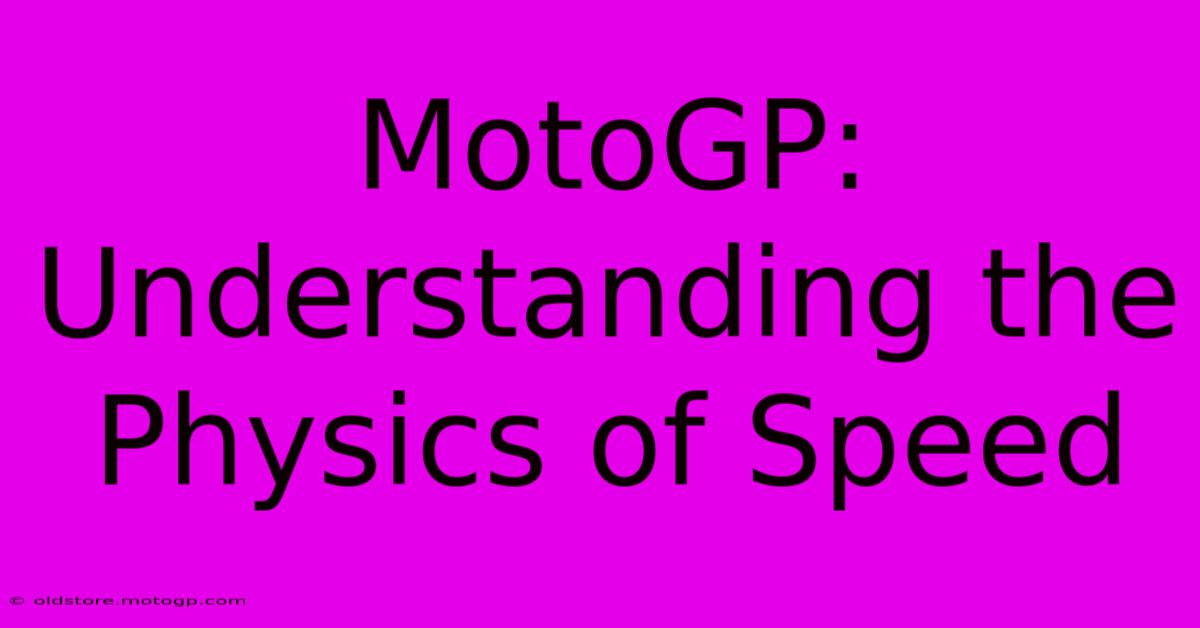MotoGP: Understanding The Physics Of Speed

Table of Contents
MotoGP: Understanding the Physics of Speed
MotoGP, the pinnacle of motorcycle racing, isn't just about skillful riders and powerful machines; it's a breathtaking display of physics in action. The incredible speeds, breathtaking maneuvers, and seemingly impossible cornering techniques are all governed by fundamental principles of physics. Let's delve into the science behind the speed and excitement of MotoGP.
The Physics of Acceleration and Speed
The sheer speed of MotoGP bikes is a testament to the interplay of several factors. Powerful engines, producing hundreds of horsepower, are the obvious starting point. However, it's not just brute force; efficient power delivery is crucial. The engine's ability to smoothly and consistently deliver power across the rev range allows for optimal acceleration out of corners and on straights.
Factors Influencing Acceleration:
- Engine Power and Torque: Higher power and torque figures translate directly into quicker acceleration. The engines are meticulously tuned to deliver maximum power within the specific RPM range demanded by the track.
- Aerodynamics: MotoGP bikes are aerodynamic marvels. Streamlined fairings and winglets minimize drag, allowing the bikes to reach higher top speeds and accelerate more rapidly. The design constantly evolves, with teams constantly seeking to reduce drag and improve downforce.
- Tire Grip: The level of grip available from the tires is paramount. Specialized tires with incredibly high levels of grip allow for maximum acceleration without wheelspin. The tire compound, pressure, and even temperature play a crucial role.
- Rider Skill: A skilled rider can maximize acceleration by expertly managing throttle input, body position, and gear selection, ensuring the power is transferred to the ground efficiently.
Cornering: The Art of Controlled Physics
MotoGP racing isn't just about straight-line speed; it's equally about mastering the art of cornering at incredibly high speeds. This involves a complex interplay of forces:
Understanding the Forces:
- Centrifugal Force: As a bike leans into a corner, centrifugal force pushes it outwards, trying to make it slide off the track.
- Friction: Friction between the tires and the track surface provides the grip that counteracts centrifugal force, preventing the bike from sliding. The angle of lean, tire pressure, and track conditions all influence friction.
- Downforce: Aerodynamic elements like winglets generate downforce, pressing the bike onto the track and increasing grip, especially at high speeds and in corners. This allows for higher cornering speeds.
- Rider Technique: The rider's skill in counter-steering, body positioning, and brake application is crucial in managing these forces effectively.
The Role of Braking
Effective braking is just as vital as acceleration and cornering. MotoGP bikes employ advanced braking systems with immense stopping power. This requires precise control to avoid locking up the wheels and losing control.
Key Aspects of Braking:
- Brake System Technology: High-performance brake calipers, discs, and master cylinders are crucial for providing the necessary stopping power.
- Brake Balance: The rider needs to skillfully distribute braking force between the front and rear brakes to achieve optimal stopping distance and stability.
- Tire Grip: Just like in acceleration, maintaining tire grip during braking is essential to avoid skidding.
- Rider Skill: Anticipating braking points, smoothly applying brakes, and maintaining stability under heavy braking requires years of experience and skill.
The Constant Pursuit of Performance
The pursuit of speed in MotoGP is a never-ending quest for optimization. Teams constantly refine their machines, employing advanced materials, sophisticated electronics, and detailed data analysis to gain even the slightest advantage. This constant innovation pushes the boundaries of what's physically possible on two wheels.
In Conclusion:
MotoGP racing is a fascinating spectacle of physics in action. Understanding the underlying principles of acceleration, cornering, and braking is key to appreciating the incredible skill of the riders and the sophisticated engineering of the machines. The seemingly impossible feats performed on the track are ultimately a precise choreography of physics, honed to perfection through tireless innovation and unwavering dedication.

Thank you for visiting our website wich cover about MotoGP: Understanding The Physics Of Speed. We hope the information provided has been useful to you. Feel free to contact us if you have any questions or need further assistance. See you next time and dont miss to bookmark.
Featured Posts
-
Get The Best F1 Us Grand Prix Tv Coverage Insider Tips
Feb 23, 2025
-
Cota One Day Pass Your Key To Columbus Discovery
Feb 23, 2025
-
Maximize Your Potential With Lot F Cota
Feb 23, 2025
-
Honda Moto Gp Experience The G Force
Feb 23, 2025
-
Experience The Legend Cota Open Track Days
Feb 23, 2025
